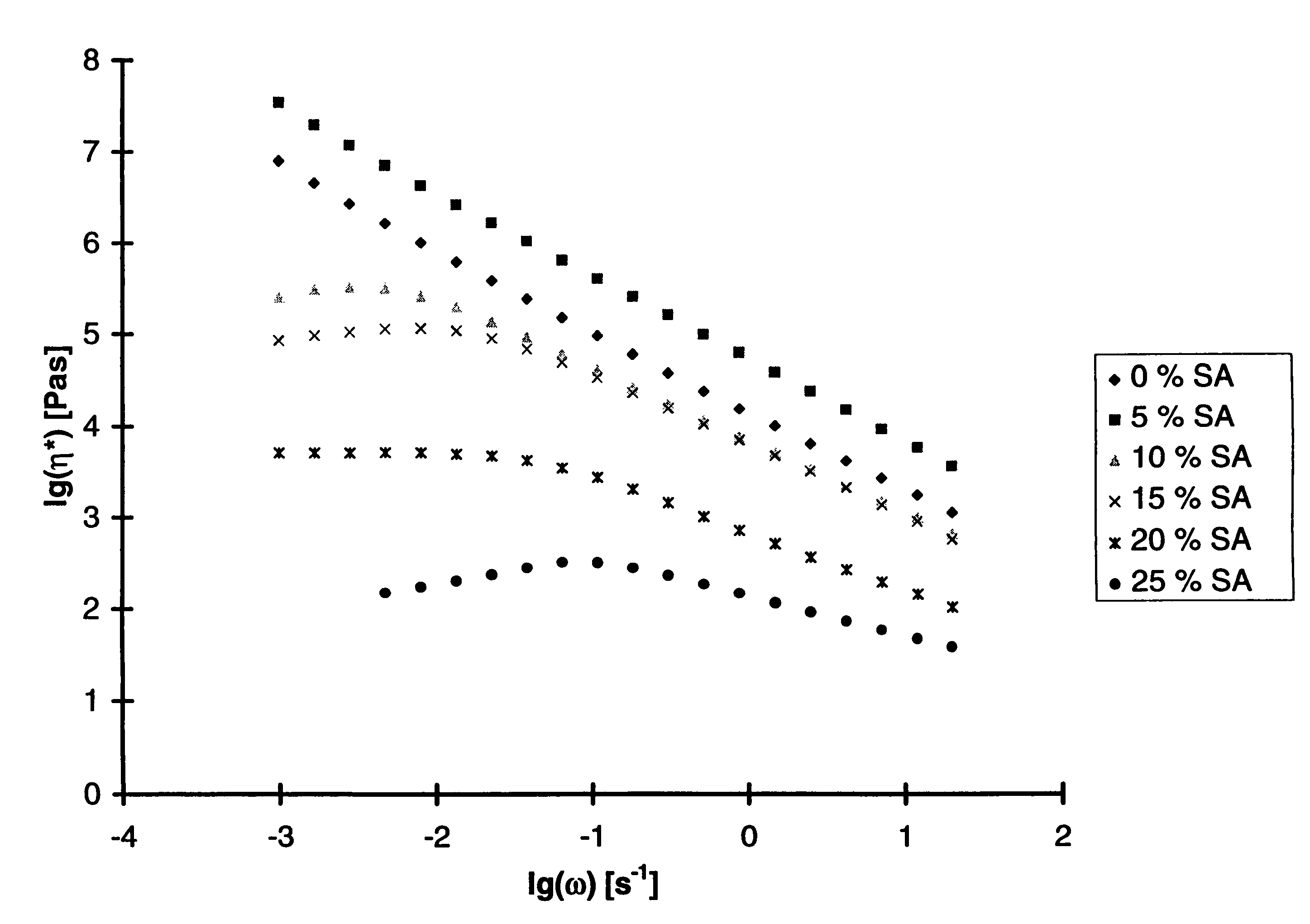Thermotropic main-chain liquid crystalline polymers and method of increasing the melt processibility of polyester-based liquid crystalline polymers
a liquid crystalline polymer and thermoplastic technology, applied in the field of liquid crystalline polymers, can solve the problems of poor transverse direction, poor tensile strength of an lcp, and almost impossible to obtain even thickness profiles in films, so as to achieve sufficient molecular weight and length, and improve processability
- Summary
- Abstract
- Description
- Claims
- Application Information
AI Technical Summary
Benefits of technology
Problems solved by technology
Method used
Image
Examples
example 1
[0126]Polyester-Based Liquid Crystalline Polymers
[0127]Polycondensations
[0128]A) In Bulk
[0129]PET (30 mmol), 4-acetoxybenzoic acid (45 mmol), acetylsalicylic acid (8.3 mmol) and dibutyltin oxide were weighed into a cylindrical glass reactor equipped with a mechanical stirrer, a gas-inlet and gas-outlet tube. The reaction vessel was placed in a metal bath preheated to 140° C. and the temperature was rapidly raised to 280° C. (20 min.). Prior to the heating the air was removed by flushing with nitrogen and the acetic acid evolved in the course of 1 h (at 280° C.) and was also removed with a slow stream of nitrogen. After 1 h, vacuum was applied and the stirring was continued for 4 hours more at 280° C. The cold reaction product was dissolved in a mixture of CH2Cl2 and trifluoroacetic acid (TFA, volume ratio 4:1), precipitated into methanol and dried at 80° C. in vacuo. This procedure corresponds to experiment No. 2, Table 1. All other experiments of this Table were conducted analogous...
example 2
[0140]Polymers were synthesized by polycondensation and transesterification in bulk at temperatures up to 280° C. using titanium tetraisopropoxide as catalyst. N-(4-carboxy-phenyl) trimellitimide, acetylated tert.-butylhydroquinone, acetyl salicylic acid (ASA) were used as monomers and commercial PET served as reaction partner for two series of experiments. Tert.-butylhydroquinone was selected as comonomer, because it favours the formation of non-crystalline copoly(ester imide)s, having high glass-transition temperatures (Tg's) and a broad temperature range of the nematic phase. Phenyl-hydroquinone imparts the same properties, but it is more expensive, whereas methyl and chlorohydroquinone favour the formation of crystallizable blocks.
[0141]A first series of copoly(ester imide)s was prepared just by copolycondensation of N-(4-carboxyphenyl) trimellitimide, acetylated tert.-butylhydroquinone and ASA with variation of the molar fraction of ASA. The results are listed in Table 5.
[0142]...
example 3
[0154]Polycondensation of HNA and HBA (3:7) with Addition of 10 mol % ASA
[0155]6.91 g (30 mmol) 6-acetoxy-2-naphthoic acid, 12.61 g (70 mmol) 4-acetoxybenzoic acid, 2.00 g (11.1 mmol) acetylsalicylic acid and 30 mg magnesium oxide were weighed into a cylindrical glass reactor, which was treated with dimethyl dichlorosilane and washed with dry ether before use. The reactor was equipped with a mechanical stirrer and gas inlet and outlet tubes. The reaction mixture was placed into a metal bath preheated to 120° C. The flask was evacuated and purged with nitrogen four times to remove all air. The temperature was then quickly raised to 240° C. After 20 minutes the mixture was a homogeneous melt and within 2 hours the temperature was raised to 340° C. in a stepwise manner. The evolved acetic acid was removed with a slow stream of nitrogen. Finally, vacuum was applied for 0.5 hours while stirring was continued.
[0156]Yield: 13.1 g (88%)
[0157]Tg=98° C.
[0158]Tm1=266° C.
[0159]Tm2=343° C. (all ...
PUM
| Property | Measurement | Unit |
|---|---|---|
| mol % | aaaaa | aaaaa |
| melting point | aaaaa | aaaaa |
| temperature | aaaaa | aaaaa |
Abstract
Description
Claims
Application Information
 Login to View More
Login to View More - R&D
- Intellectual Property
- Life Sciences
- Materials
- Tech Scout
- Unparalleled Data Quality
- Higher Quality Content
- 60% Fewer Hallucinations
Browse by: Latest US Patents, China's latest patents, Technical Efficacy Thesaurus, Application Domain, Technology Topic, Popular Technical Reports.
© 2025 PatSnap. All rights reserved.Legal|Privacy policy|Modern Slavery Act Transparency Statement|Sitemap|About US| Contact US: help@patsnap.com



